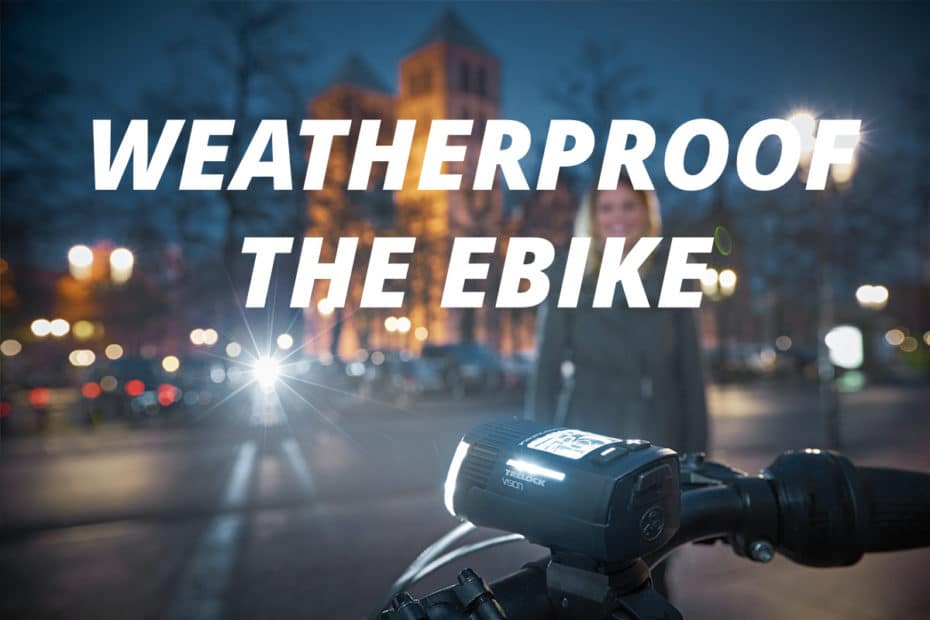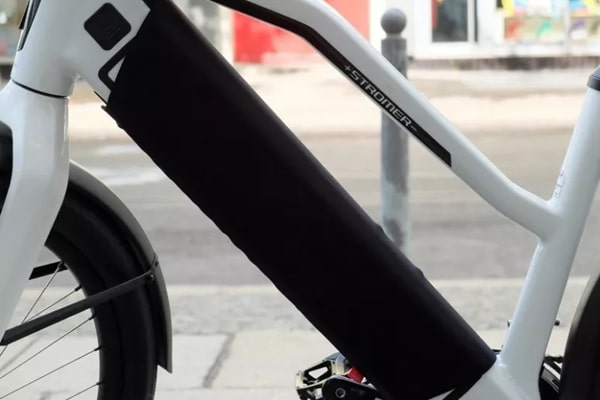Of course, we also ride our ebikes in autumn and winter, no matter how bad the weather. After all, bikes with electric drives are just as well designed for riding in the rain, cold and dirt. We have some tips for you on how to make your ebike weather-proof and ready for the bad conditions.
- Does rain damage my ebike?
- Cold temperatures: what happens to my ebike battery?
- How do I protect the ebike display or remote control?
- The right ebike lighting: headlights and taillights
1. Does rain damage my ebike?
No. The sensitive electronics of an ebike are also protected from rain and splash water. However, it goes without saying that you should never immerse the motor or battery in water. It is therefore vital to avoid puddles that are too deep.
If you also want to protect the battery and motor from moisture, you are well advised to use special neoprene covers. These also protect against the cold. They are primarily used for safe transport and storage. Covering motors with a neoprene cover while riding hardly seems advisable. In the case of batteries, however, this is very much an advantage.
Neoprene covers such as those made by Fahrer protect both motors and batteries from splash water and other environmental influences. They can be attached stably with Velcro fasteners and fit smoothly to the components.
2. Cold temperatures: what happens to my ebike battery?
The battery of an ebike consists of very sensitive components. The energy storage works most effectively in a temperature range of 20 degrees Celsius to 25 degrees Celsius. At temperatures as low as minus 10 degrees Celsius, performance can be impaired. The reason for this is the electrochemical processes inside the battery.
The possible loss of energy is related to the electrolyte, a viscous substance in the individual cells of the lithium-ion batteries. When it gets cold, it becomes more viscous, making it harder for the ions to penetrate it. This property is different for each battery, however, because the manufacturers use different materials.
If you are riding your ebike in low temperatures, you should simply put a neoprene cover on the battery. It provides effective thermal protection and keeps out most of the extreme cold.
If an ebike is stored in a cool place for a longer period of time, it is better to remove the battery. A dry room that has been warmed to room temperature is a much better place for it. The charge level should be between 30 and 60 percent. If necessary, check the charge level regularly and recharge the battery in between if it has too little energy. Practical: If you already have a neoprene cover for the battery, you can of course also store it in it.
The contacts for the battery compartment on the ebike also require attention: dirt and splash water can cause serious damage there. To prevent this from happening, manufacturers offer special caps that you can use instead of the battery. Fahrer also offers neoprene covers for this purpose.
3. How do I protect the ebike display or remote control?
If your display already features a protective film, it is at least protected from scratches. In the cold and wet season, however, a thicker, transparent protective cover is recommended. It fits snugly on the display and protects it from light rain and splashing water – but you can still operate the display.
For tougher conditions, heavy rain or storage, a neoprene cover is recommended. The display can then no longer be operated, but it is well protected from moisture. In the meantime, there are even complete handlebar covers. However, these are of course not intended for riding, but are suitable for optimal storage or for transporting the ebike by car.
4. The right ebike lighting: headlights and taillights
In road traffic, it is crucial to be clearly visible to other people and at the same time to be able to recognise all possible dangers and obstacles in good time yourself. The right lighting system on your ebike and pedelec is therefore essential. It will keep you safe in the semi-darkness on your way to work, in deep fog or in a heavy downpour.
Lux and lumen – what is the difference? Manufacturers state the luminosity of their lights either in lux or lumens. Annoyingly, this leads to confusion and makes comparison difficult. Simply put, lumen refers to the luminous efficacy, i.e. how much light the lamp emits. Lux refers to the illuminance or brightness with which the light then hits the surface.
Lighting systems that do not require additional power from a cell or dynamo are practical. They are powered directly from the battery and can be switched on and off using the light switch on your ebike.
Ebike headlights
Supernova M99 Pro 2
Brightest German StVZO-approved front light for ebikes, high beam of 3,000 lumens or 450 lux, low beam of 500 lumens or 130 lux
Lupine SL Nano
Compact headlight with sophisticated lens technology and polycarbonate optics, 900 lumen high beam, 600 lumen low beam
Busch&Müller IQ-XS E
Super price-performance ratio, wide light field, sensor-controlled daytime running light like in a car, 70 lux
Ebike tailights
Supernova TL3 Max
A total of 52 power LEDs make the brightest German StVZO-approved rear light visible from afar.
Lupine C14 SP BL
Klein, aber oho – minimalistisches Rücklicht zur Montage an der Sattelstütze mit Bremslicht und 45 Lumen
Busch&Müller Toplight Line Brex
Affordable tail light featuring sensor-controlled brake light function for light output with voltage from 5 V to 15 V
Pictures: Fahrer Berlin GmbH; Lupine Lighting Systems GmbH; Supernova Design GmbH; Busch & Müller KG
















The electrical components of your e-bike are the most sensitive to water damage. Make sure to seal any openings in the controller, motor, and battery with silicone sealant. You can also wrap the components in heat shrink tubing or electrical tape for extra protection.
We are thinking about buying a townie for my wife. We are concerned about the heat affecting our battery especially if we leave it in the garage. It seems that the correct thing to do is to store it inside our house year around for appropriate protection against the heat in the cold of the Nebraska weather.
Would you mind sharing your thoughts or advice with us on this topic? Thank you
Hello Don,
We are not necessarily the climate experts for Nebraska 😉 Furthermore, we don’t know how warm it can get in your garage in summer. Therefore, we can only give general advice at this point. The advantage of a Townie is certainly that Bosch systems are installed in these ebikes. This means that you can assume good workmanship and a high-quality battery management system. In any case, you should avoid direct sunlight over a longer period of time at temperatures of 30 degrees Celsius and more. However, the battery registers this itself. It is equipped with a temperature monitoring system. This allows charging only in the temperature range between 0 °C and 40 °C. Therefore, storage at room temperature and normal humidity is always a good measure. Such conditions generally extend the life of the battery. If you then use it regularly or charge it at least once a month so that it always retains between 30 and 60 per cent of its capacity, you should be able to rely on the battery for quite a long time.
Cheers, Matthias